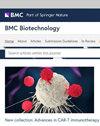Validation and calibration of a novel GEM biosensor for specific detection of Cd2+, Zn2+, and Pb2+
IF 3.5
3区 生物学
Q2 BIOTECHNOLOGY & APPLIED MICROBIOLOGY
引用次数: 0
Abstract
In this study, we designed a novel genetic circuit sensitive to Cd2+, Zn2+ and Pb2+ by mimicking the CadA/CadR operon system mediated heavy metal homeostasis mechanism of Pseudomonas aeruginosa. The regular DNA motifs on natural operon were reconfigured and coupled with the enhanced Green Fluorescent Protein (eGFP) reporter to develop a novel basic NOT type logic gate CadA/CadR-eGFP to respond metal ions mentioned above. A Genetically Engineered Microbial (GEM)-based biosensor (E.coli-BL21:pJET1.2-CadA/CadR-eGFP) was developed by cloning the chemically synthesised CadA/CadR-eGFP gene circuit into pJET1.2-plasmid and transforming into Escherichia coli (E. coli)-BL21 bacterial cells. The GEM-based biosensor cells indicated the reporter gene expression in the presence of Cd2+, Zn2+ and Pb2+ either singly or in combination. Further, the same biosensor cells calibrated for fluorescent intensity against heavy metal concentration generated linear graphs for Cd2+, Zn2+ and Pb2+ with the R2 values of 0.9809, 0.9761 and 0.9758, respectively as compared to non-specific metals, Fe3+ (0.0373), AsO43− (0.3825) and Ni2+ (0.8498) making our biosensor suitable for the detection of low concentration of the former metal ions in the range of 1–6 ppb. Furthermore, the GEM based biosensor cells were growing naturally within the concentration range of heavy metals, at 37 °C and optimum pH = 7.0 in the medium, resembling the characteristics of wildtype E.coli. Finally, the novel GEM based biosensor cells developed in this study can be applied for detection of targeted heavy metals in low concentration ranges (1–6 ppb) at normal bacterial physiological conditions.验证和校准用于特异性检测 Cd2+、Zn2+ 和 Pb2+ 的新型 GEM 生物传感器
本研究通过模仿铜绿假单胞菌 CadA/CadR 操作子系统介导的重金属平衡机制,设计了一种对 Cd2+、Zn2+ 和 Pb2+ 敏感的新型基因电路。通过重新配置自然操作子上的常规 DNA 主题,并与增强型绿色荧光蛋白(eGFP)报告器结合,开发出一种新型的基本 NOT 型逻辑门 CadA/CadR-eGFP,以响应上述金属离子。通过将化学合成的 CadA/CadR-eGFP 基因回路克隆到 pJET1.2 质粒中并转化到大肠杆菌(E.coli)-BL21 细菌细胞中,开发出了基于基因工程微生物(GEM)的生物传感器(E.coli-BL21:pJET1.2-CadA/CadR-eGFP)。基于 GEM 的生物传感器细胞在 Cd2+、Zn2+ 和 Pb2+ 单独或混合存在时都能显示报告基因的表达。此外,与非特异性金属 Fe3+(0.0373)、AsO43-(0.3825)和 Ni2+(0.8498)相比,根据重金属浓度校准荧光强度的同一生物传感器细胞对 Cd2+、Zn2+ 和 Pb2+ 生成的线性图的 R2 值分别为 0.9809、0.9761 和 0.9758,使我们的生物传感器适用于检测 1-6 ppb 范围内的低浓度前者金属离子。此外,基于 GEM 的生物传感器细胞在重金属浓度范围内,在 37 °C 和最适 pH = 7.0 的培养基中自然生长,与野生型大肠杆菌的特征相似。最后,本研究开发的基于 GEM 的新型生物传感器细胞可用于在正常细菌生理条件下检测低浓度范围(1-6 ppb)的目标重金属。
本文章由计算机程序翻译,如有差异,请以英文原文为准。
求助全文
约1分钟内获得全文
求助全文
来源期刊

BMC Biotechnology
工程技术-生物工程与应用微生物
CiteScore
6.60
自引率
0.00%
发文量
34
审稿时长
2 months
期刊介绍:
BMC Biotechnology is an open access, peer-reviewed journal that considers articles on the manipulation of biological macromolecules or organisms for use in experimental procedures, cellular and tissue engineering or in the pharmaceutical, agricultural biotechnology and allied industries.
 求助内容:
求助内容: 应助结果提醒方式:
应助结果提醒方式:


